You don’t need a crystal ball to know that if you’ve been dreaming of waddling penguins, breaching whales, and towering icebergs, an Antarctica expedition is your destiny. What your dream state is unlikely to be telling you, however, is when is the best time of year to visit Antarctica! You’ll need to know this so you can book that dream-becomes-reality vacation. That’s where our handy guide comes in, revealing everything you need to know about when to travel to the white continent.
It’s a rare traveller that doesn’t have Antarctica on their list of travel goals. It’s as away-from-it-all as you can get; a destination filled with intrigue, awe and surprises. Plus, its history of daring endeavours sheds light on the tenacity of the human spirit. Choosing when to go to Antarctica is as important as the thermals you pack and the camera or phone’s storage (spoiler alert: you will need more than you think).
The best time of year to visit Antarctica is not as simple as us saying “mid-December to mid-February”, when wildlife is at its most active. What if you’re looking for the most classic Antarctic experience? Then the start and the end of the season would suit. Or perhaps, since watching Happy Feet, you’ve been yearning to see young penguins take their first plunge? Then book a February departure.
As experts in expedition cruising for decades, we’ve compiled this handy month-by-month travel guide so you can select the best time to visit Antarctica. From when we set sail in October and return from our last trip of the season in March, there’s no best or worst time to travel to Antarctica, in our opinion. There are absolute highlights on every sailing!
When should I go to Antarctica?
You might think of Antarctica as only having one season (cold!), but there are actually two distinct seasons. The two seasons – winter and summer – are due to the Earth’s tilt and orbit around the sun. Both impact the weather, the wildlife and when you should plan your visit.
Winter in Antarctica
For six months, sea ice surrounds Antarctica, making it almost impossible to get there. It’s also during winter that the region plunges into darkness. Around 21 June, the sun vanishes over the horizon and doesn’t reappear for weeks.
Winter is when whales begin their long migration towards the equator to breed. Those penguins you can’t wait to see? They also flee north towards the advancing ice edge. In fact, the only warm-blooded animal that has the audacity to face Antarctica’s most hostile months is the staunch emperor penguin.
The lack of access and the fact that most of the wildlife on your Antarctica bingo card has migrated north tells you winter is not the ideal time to visit.
Summer in Antarctica
As always, in nature, there is balance. What is dark becomes light. What is cold becomes hot. Or ever-so-slightly warmer, in Antarctica’s case. The return of the sun sees the sea ice break lose, the glorious residents – whales, penguins, seals, and sea birds – return in droves, and Aurora Expeditions’ welcoming crew, Expedition Leader, and onboard experts excitedly prepare to set sail to the white continent for a new season of adventures.
With the best times to travel to Antarctica covering half of the year, it is no surprise there are fluctuations and changes over that long window of opportunity to explore the region. It’s important to understand the best months to meet your travel goals so you can get a clearer idea of when to set sail.
Choosing the best time to travel to Antarctica means knowing what activities are available and what wildlife is most active, when. No matter what, each month in Antarctica has its unique charms. The only disappointment when travelling to Antarctica is that the trip ends!
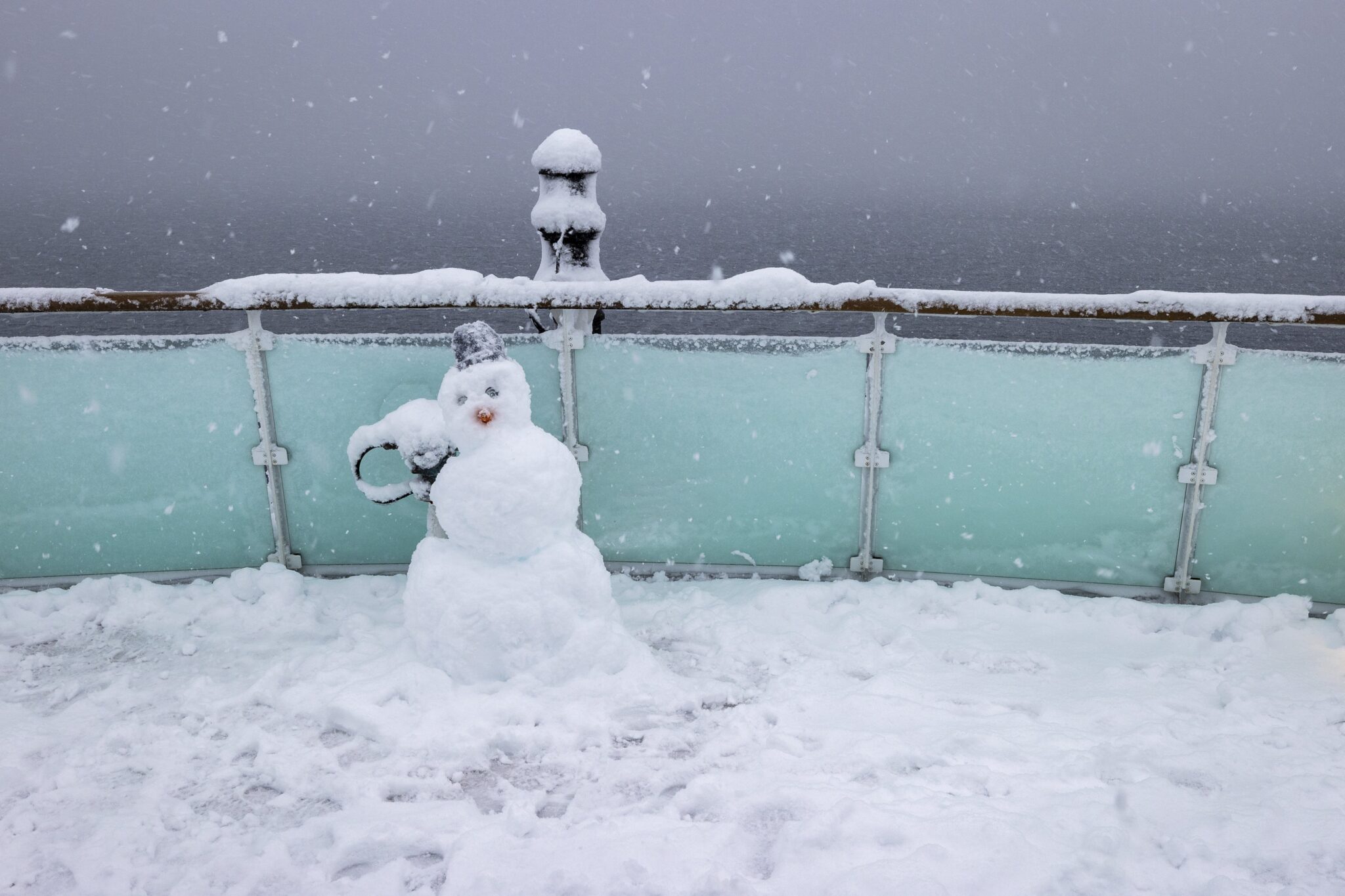
October & November
Quick guide: October and November offer untouched Antarctica with pristine landscapes, abundant sea ice and ample adventure opportunities.
When you set sail in October and November, fresh white snowscapes, slow, luminous sunsets and an ocean filled with residual sea ice await. If you’re into photography, this is an optimal time to visit. Especially as our onboard professional photographer is on hand to maximise your results. Fun fact: there is an Aurora Expeditions resident photographer on every sailing!
October is also when penguins return to the Antarctic Peninsula en masse. Seeing their signature waddle traversing a snowy slope is a memory that will last you a lifetime. If you’re fortunate, you may even witness them building their nests from small stones and their intricate courtship rituals.
From October onwards, whales also return to their feeding grounds. While eight whale species are spotted in Antarctica, there are three thrilling main whales to witness in action.
If you like a good workout while on holiday, the deep snow at some landing sites will be your training ground. Some pre-trip training is helpful for departures at this time of year, as is packing your trekking poles, or utilising the ones offered once onboard (more on packing later).
Come November, spotting an egg tucked between the legs of a penguin is an aww-worthy site. Seasonal timings vary between locations, though. November is also the month to keep your eyes peeled to maximise your chances of witnessing elephant seal pups being hauled from the ice by their colossal parents. Did you know they can’t go in the water until their moulting is complete?
A bonus of going earlier in the season for active travellers is the possibility of extra activities that put you in the middle of the action. Like camping on the ice, snowshoeing, and skiing and snowboarding (additional costs may apply). Our popular Spirit of Antarctica departures are ideal for unique add-on activities.
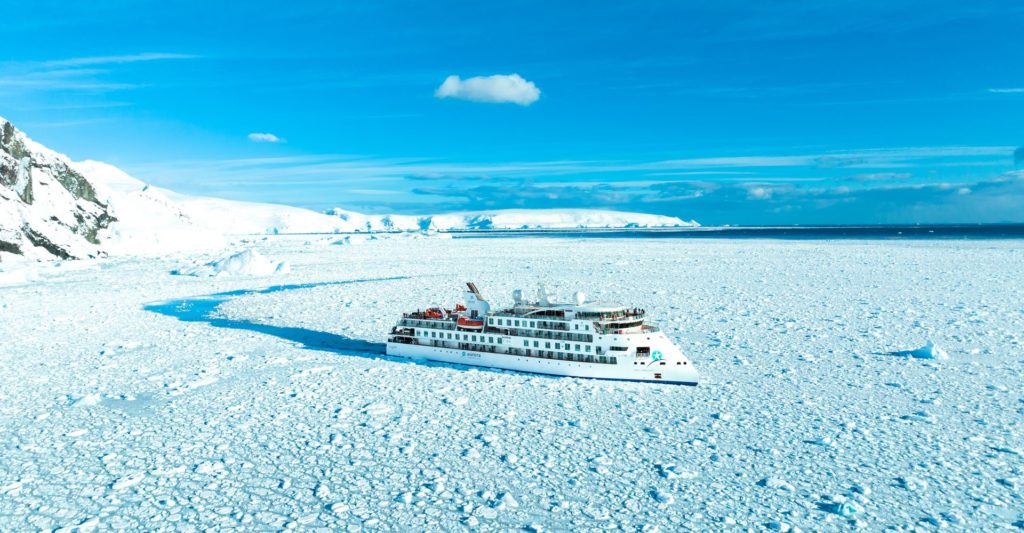
Spirit of Antarctica
Embrace the spirit of polar exploration on this classic expedition to the coveted white continent. Sail across the famed Drake Passage to and from Antarctica, admiring spectacular seabirds and approaching the ice as the explorers of old did: by sea.
With a chance to Zodiac cruise through pack ice, set foot on the continent, choose from a range of adventure options and even perhaps camp under pastel polar skies, this is the quintessential Antarctic voyage for adventure-lovers.
Embrace the spirit of polar exploration on this classic expedition to the coveted white continent. Sail across the famed Drake Passage to and from Antarctica, admiring spectacular seabirds and approaching the ice as the explorers of old did: by sea.
December & January
Quick guide: Stable weather, easier landings and newborns and juveniles across the continent, December and January are two of the most popular months to visit.
That summer feeling we all know and love is evident across all species it seems, with the penguin colonies buzzing with new life and doting parents. Seeing the downy plumage of a penguin chick is bound to give you the warm and fuzzies – and fabulous photos, of course.
However, it is not only penguins. By December, the ocean is teeming with whales feeding and crabeater seals hauling their rotund bodies onto ice floe. Plus, there’s the occasional elephant seal appearing like a celebrity at a VIP event. Many consider December one of the best months to visit Antarctica because you can also experience the ultimate white Christmas or sail into a New Year in an entirely new way!
Like Januarys the world over, the kids are playing up. Only instead of back-to-school uniforms and stationery runs, Antarctica’s penguin chicks are starting to form creches and tear through the colony with vigour and glee. It’s now that the adults begin to moult, too.
Across the continent, the sea level snow begins to melt as the days grow warmer and the temperatures rise, exposing rocky terrain in its place. When the sea ice has melted, crossing the Drake Passage is easier and traditionally calmer.
Both December and January optimise your activities and Zodiac expedition time, as you’ll enjoy around 20+ hours of daylight! That also means more time to say yes to our polar kayaking and scuba diving optional activities. Getting on or in the icy water is the ultimate way to experience Antarctica, especially if you’re brave enough to take the polar plunge!
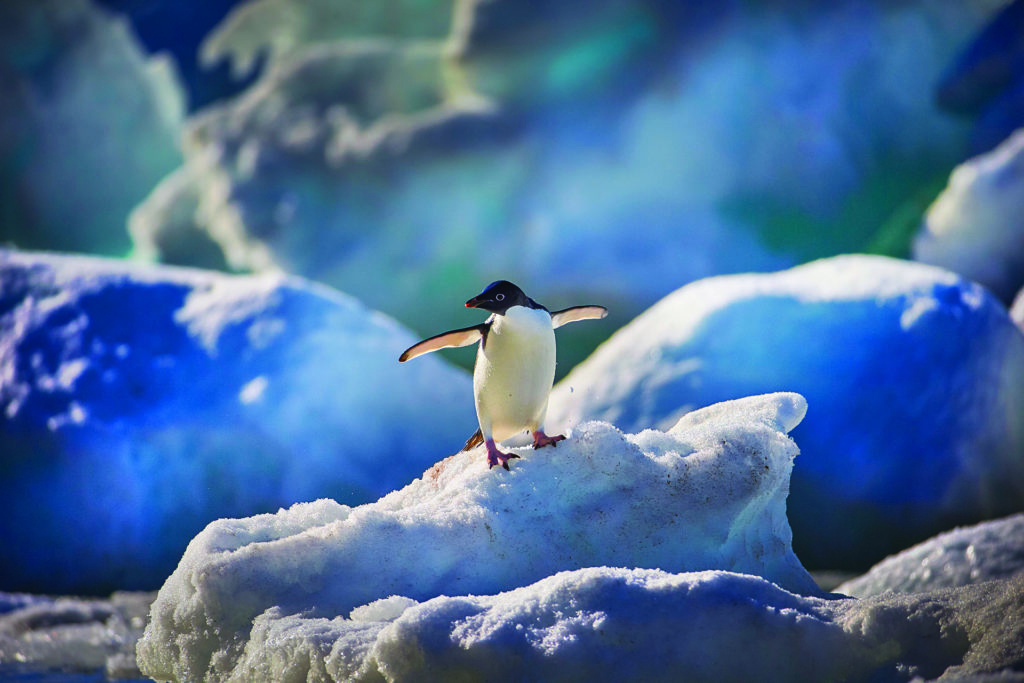
Across the Antarctic Circle
Venturing below the Antarctic Circle is about more than just earning bragging rights. It is the chance to enter a different world, rarely seen, it feels more isolated and colder than further north, with great swathes of pack ice and dreamlike icebergs.
Venturing below the Antarctic Circle is about more than just earning bragging rights. It is the chance to enter a different world, rarely seen, it feels more isolated and colder than further north, with great swathes of pack ice and dreamlike icebergs.
Thread through pack ice and narrow channels where scenes of ice-clad mountains, feeding whales and lively penguin colonies become lasting memories.
February & March
Quick guide: These are prime whale-watching months, offer stunning sunrises and sunsets, plus surprising bursts of colour across the White Continent.
February can be an excellent time for an Antarctica cruise, particularly if you love wildlife-watching. The breeding frenzy has eased, adult penguins have finished moulting, and it’s time for many offspring to test their freshly waterproofed plumage.
The young penguins born earlier in the summer move through a speedy adolescence, prepping for their own turn to experience life at sea. You’ll want to have your camera charged and ready for a ton of pictures as the daring adolescents take their first tentative steps into the water. You’ll feel like it’s one of your own young, bursting with pride as they start to swim.
February and March are the best months to see whales in Antarctica, as they enjoy a buffet feast on the abundant krill. Watch for leopard seals resting on the ice near penguin colonies.
Like autumn in many destinations, fall brings bursts of colour with vibrant splashes of pink and green dotting the ice. This snow algae looks as pretty as toppings on an ice cream, however, this ‘watermelon snow’ has a laxative effect so avoid the temptation to taste it!
Like the start of the season, March’s shorter days, fading light, and spectacular sunrises and sunsets leave photographers (and passengers) breathless. Returning floating sea ice amplifies that winter-is-coming feeling.
Consider the February departures on our Antarctic Explorer if you’d love to spend your days witnessing these joys! For a March trip, Wild Antarctica is an epic fly-sail adventure.
Discover why Naturalist and Expedition Leader Dr. Roger Kirkwood prefers Antarctic trips in March.
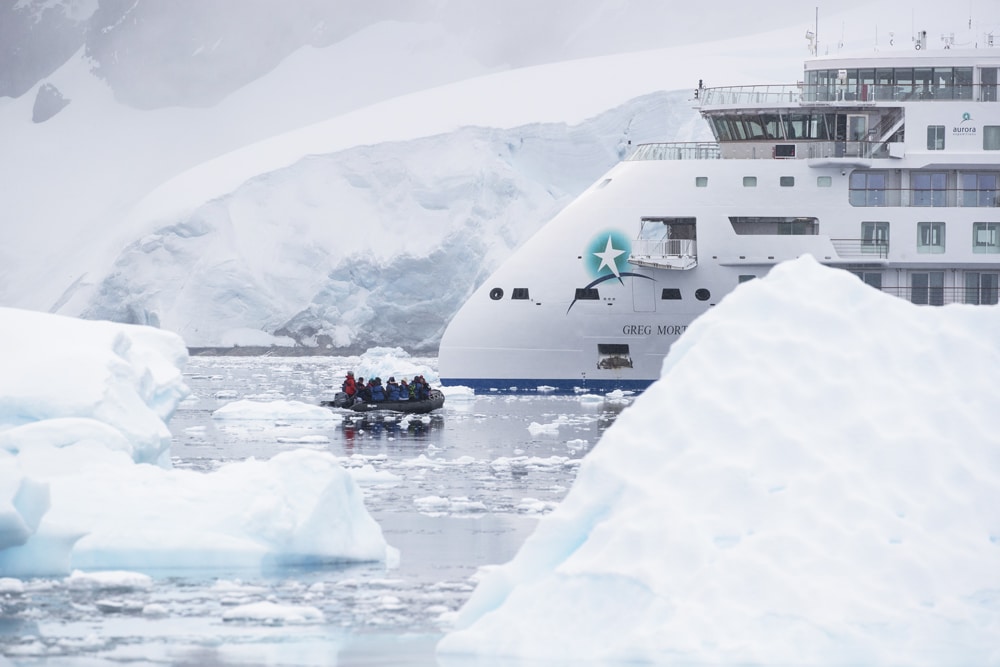
Antarctic Explorer
Early Antarctic explorers returned from their voyages to the deep south with tales of a magnificent, ice-covered land teeming with life. Experience the awe-inspiring immensity of Antarctica, reducing your time on the high seas by flying across the Drake Passage in one direction.
Immerse yourself in the unimaginable beauty of the Antarctic Peninsula, where vast glaciers tumble into the sea, penguins are dwarfed by soaring peaks and humpback and minke whales feast on abundant krill.
Immerse yourself in the unimaginable beauty of the Antarctic Peninsula, where vast glaciers tumble into the sea, penguins are dwarfed by soaring peaks and humpback and minke whales feast on abundant krill.
What to pack for an Antarctica expedition
Now you know the best time to visit Antarctica, you’ll need to know what to pack for your expedition. Luckily, as experts for over 33 years, we have everything you need to know to ensure you experience the white continent in comfort.
The most important thing to know? Pack layers! You can check out our layering guide here, but the key takeaway is to wear several light layers and one heavy one to insulate your body effectively.
So, what is Antarctica’s weather like from October to March? Chilly is a very generous word to describe either end of the season, with lows around –5.5°C (22°F). In December and January, temperatures are around 1°C (34°F) – positively balmy! You can see why those layers are a good idea, right?
Essentials in your luggage include waterproof trousers, a polar fleece jacket and thermal undies. Wool mittens, gloves and headgear will keep your extremities nice and toasty.
Closed-in shoes while onboard will ensure you can safely and comfortably navigate our purpose-built expedition ships. We’ll lend you a pair of muck boots to wear on shore excursions, so you don’t need to pack bulky footwear for the frigid temps.
Every Aurora Expeditions passenger also receives a complimentary polar expedition jacket. This custom-designed 3-in-1 jacket will be your new best friend, trust us.
Travel tips & safety
For polar explorers during the Golden Age of Antarctic Exploration, Antarctica was not considered a safe destination. Sir Douglas Mawson would attest to this after he lost members of his party and dogs to a deadly crevasse fall. When you’re travelling with the expedition experts, however, you’re protected from the temperamental elements.
Unlike Mawson aboard a 19th-century wooden vessel, you’ll be aboard one of our two modern purpose-built ships – the Greg Mortimer and the Sylvia Earle. Their design ensures safety and comfort as we navigate nature’s most intense conditions.
You’ll also enjoy our small-ship capacity (maximum 132 per departure) and robust Expedition-Team-to-guest ratio. While not a safety feature of the ship, consider our 100% climate-neutral status as a safety feature for the planet.
If you come prepared for your Antarctica trip and always follow the Expedition Team’s instructions, you will be safer than in many other destinations in the world. In fact, the only real problem you may face on Antarctica sailings is the unpredictable elements. This typically affects those who suffer from motion sickness, so it pays to bring medication, sea bands and ginger sweets. Of course, we have medical staff on every sailing to assist when needed.
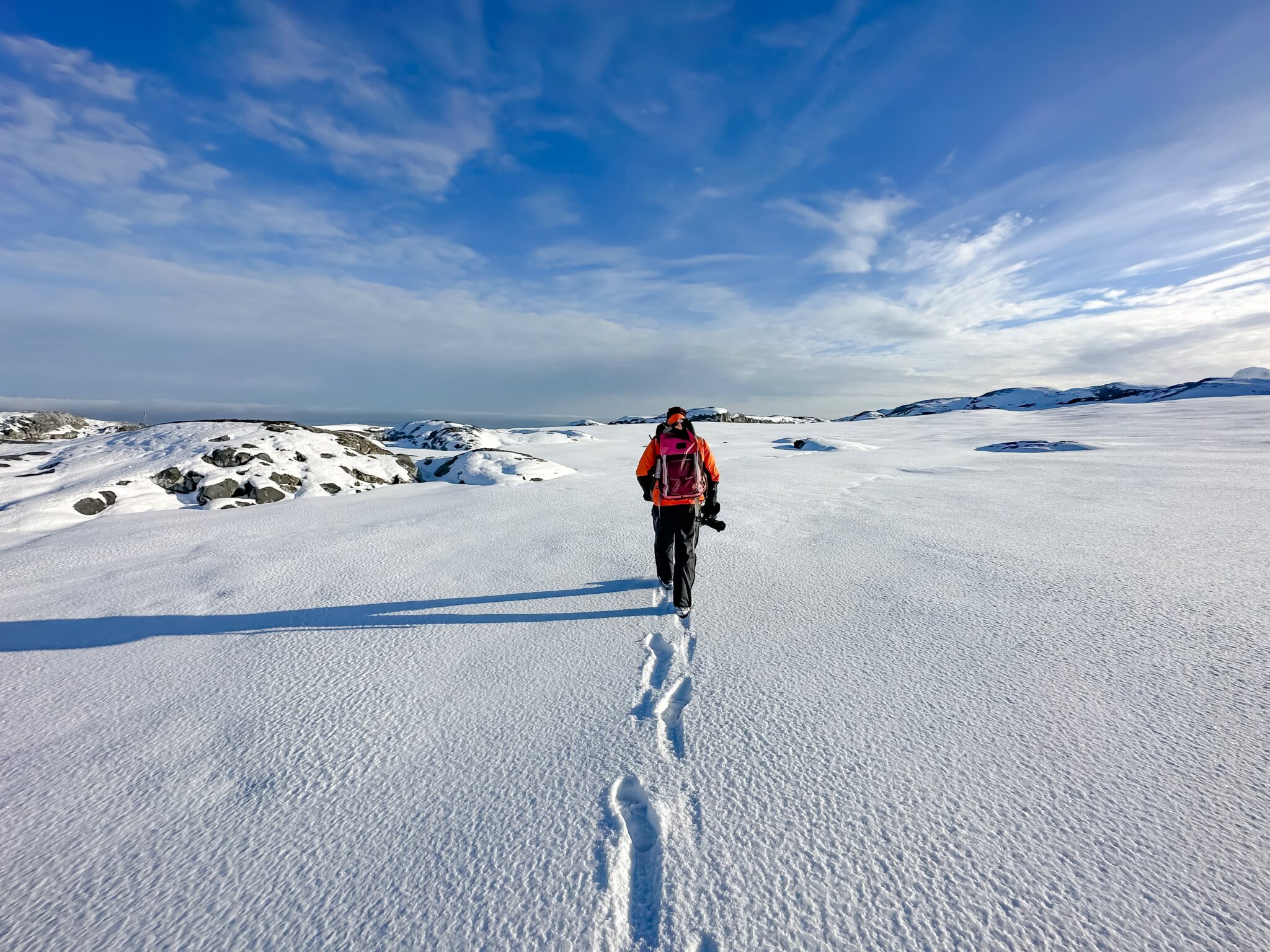
Choosing your ideal departure
It’s time for the fun part! Do you prefer the sound of witnessing Antarctica’s untouched wilderness at the start of the season, watching the continent come alive with new life, or the colour explosion that occurs towards the end of the season?
Whatever you decide, now you know the best time of year to visit Antarctica, you can find a departure to ensure you tick off those Antarctica bucket list items!
With over 25 annual departures – including fly/sail options – you can be assured there’s a sailing and stateroom with your name on it. Call our knowledgeable team to book your spot or for help answering any questions you have about travelling with us, including how to get to Antarctica. Check out some featured expeditions below or download or order our latest brochure to view the full range of Antarctica itineraries.
Antarctic Peninsula in Depth
Expedition
Welcome to Aurora Expeditions’ Antarctic Peninsula In Depth expedition. The ultimate expedition to the Antarctic Peninsula that seeks to include visits to some well-known locations and opportunities for surprise discoveries. Enjoy...
15 Days
From USD $13,676.00/pp
Wild Antarctica featuring the Weddell Sea
Expedition
Welcome to Aurora Expeditions’ Wild Antarctica featuring the Weddell Sea expedition. Famed for its enormous icebergs, year-round sea ice, fascinating fossils and the pivotal role it played in Shackleton’s Endurance expedition,...
12-13 Days
From USD $11,676.00/pp
South Georgia, Falklands & Antarctic Odyssey
Expedition
Welcome to our South Georgia & Antarctic Odyssey expedition.This voyage encompasses the best of the Antarctic Peninsula and South Georgia. Discover historic Stanley in the Falklands~Malvinas and stand in awe...
20-21 Days
From USD $20,956.00/pp
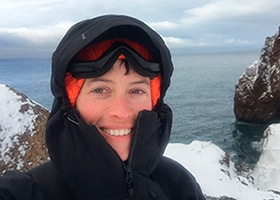
Written with assistance from Nina Gallo, Aurora Expeditions’ historian and certified PTGA polar guide.
Nina has been drawn to the polar regions since her first otherworldly experience of the midnight sun in 2002. She has spent time in far northern Canada, the Himalayas, the Alps and deserts in America and Australia, always seeking out quiet, wild corners to explore.
Nina feels immensely privileged to travel to these places and shares her passions for the natural world, human stories and adventure with all the wonderful people she meets. Nina is the author of Antarctica, published by Australian Geographic in September 2020.

